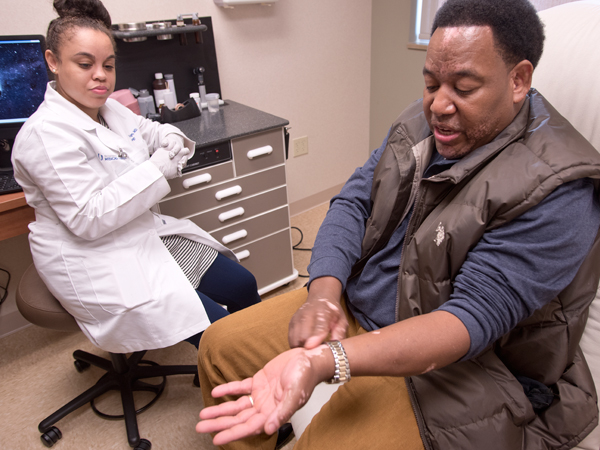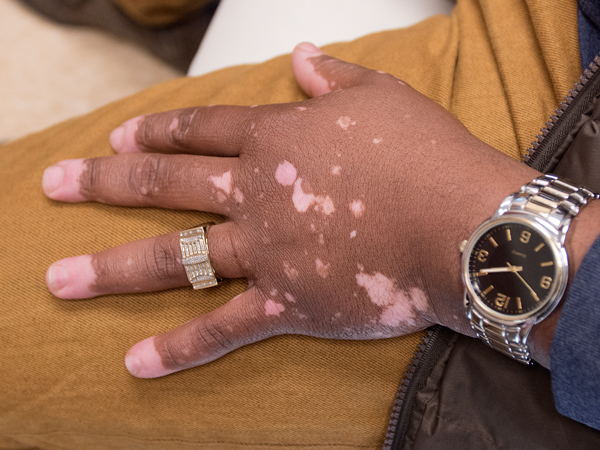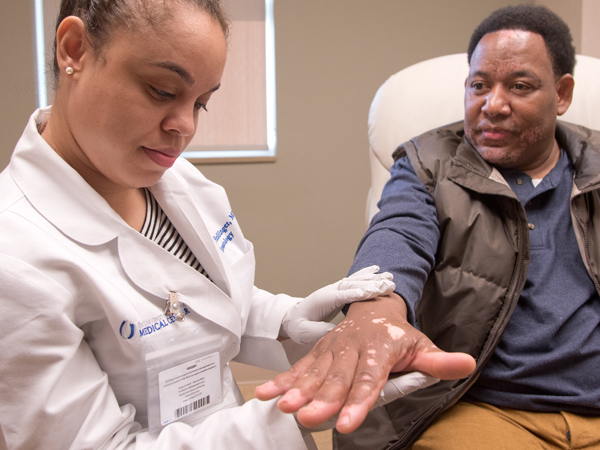Vitiligo treatments help patients get through rough patch

Published in News Stories on January 11, 2016
Barron Kaho of Fayette has a disease that's etched on his face and hands, a condition that has drained the color from his skin in patches.
He considers himself lucky.
For one thing, the disease - called vitiligo - isn't fatal. “Like I say,” he said, “it's better to be on top of the earth than under it.”
For another, the mottling began to spread about the time a new doctor came to town: UMMC dermatologist Dr. Jasmine Hollinger; her primary area of interest: vitiligo.
“She's the problem solver,” said Kaho, 45, who was referred to Hollinger by his family physician.
Under Hollinger's care, including treatments with topical steroids, Kaho has seen a 20 percent improvement in his condition, a disease that can bring ridicule from the usual cruel suspects of any race, color or creed.
“Vitiligo is not limited to any ethnic group,” said Hollinger, who earned her M.D. at the Medical Center before completing a dermatology residency at Washington D.C.'s Howard University in June.
“But it may be more stigmatizing for African Americans and others with darker skin types.”
The possibility of stigmatization apparently haunted the late pop star Michael Jackson, whose purported case of vitiligo prompted him to depigment, or bleach, all of his skin.
“I don't want to look like no Michael Jackson,” Kaho said.

Barron Kaho's vitiligo began with a spot on his forehead but spread to his hands.
Name-calling - “cow,” “zebra” - pursued Chantelle Brown-Young after she was diagnosed with vitiligo at age 4. But as an adult, she has parlayed her distinctive appearance into an international modeling career as Winnie Harlow.
It doesn't work out so well for everyone; and even though Kaho says having vitiligo doesn't bother him, he makes these stipulations: “as long as you know what it is. As long as you know it's treatable.”
Vitiligo (vit-ih-LIE-go) is not yet curable for the estimated two million Americans it has struck, but available treatments can change the appearance of their skin.
An autoimmune disease - which occurs when the body's immune system mistakenly attacks healthy tissue - vitiligo destroys the cells that produce melanin, or pigment. Doctors don't know why this happens, but it may be related to, among other things, heredity or some trigger event such as stress or sunburn.
“For some people, the condition worsens without treatment,” Hollinger said.
It can affect the skin anywhere on the body, as well as the hair, eyes and lips. It can wreck one's peace of mind.

“Many people don't come to the doctor, because they have lost all hope, or they went one time and the treatment didn't work the way they thought it should,” said Dr. Robert Brodell, professor and chair of the Department of Dermatology and professor in the Department of Pathology.
“I believe having somebody here with special expertise in the area of vitiligo will change that. The department is very lucky to have Jasmine Hollinger on our faculty. As we see patients coming back to us with this condition, we're tending to shift them to her.”
Up to 40 vitiligo patients visit UMMC's staff of 10 full-time dermatologists annually, Brodell said. “My sense is that at least 50 percent of them are African-American; individuals with dark skin are more likely to seek help.”
Asked if it's important for an African-American dermatologist to be available for these patients, considering the potential stigma, Brodell said, “absolutely.”
Hollinger, an assistant professor of dermatology hired in September, is the department's first African-American faculty member.
She returned to her native state to practice, she said, because “nobody is going to take care of Mississippians like Mississippians. I wanted to come back home and let patients know, 'Hey, I get it.'”
A Jackson native who grew up as Jasmine Campbell, she's married to Lowell Hollinger, associate director of the Jackson State University band. They wed the week before she finished medical school.
Aware since elementary school that she wanted to become a doctor - the first in her family - she said her brother's diagnosis a decade ago helped solidify her decision while she was in college.
“He has vitiligo,” she said. “There was no one here to treat him at the time, although he did find treatment in Maryland, where our father lives.
“My brother told me, 'You have to find a cure for this.' Thanks for the pressure,” she said with a laugh.
She was a third-year medical student when she chose to specialize in dermatology. “I fell in love with it. It gives you a little bit of everything.”

Dr. Jasmine Hollinger gauges the progress Barron Kaho has seen since she prescribed topical therapy for him.
After earning her M.D., Hollinger remained here for a year-long internship in internal medicine before arriving at Howard University, which is known for its vitiligo research, she said.
While vitiligo prefers no race or gender, according to the National Institute of Arthritis and Musculoskeletal and Skin Diseases, it's more visible in people with dark skin.
It's unrelated to albinism, a genetic disorder distinguished by a lack of skin pigment. But, like albinism, it can also be “psycho-socially debilitating,” Hollinger said. “And it can be challenging to treat.
“The only FDA-approved drug for vitiligo is monobenzone, which completely and irreversibly depigments the skin; it's only used in the minority of patients who have widespread disease.
“Many of the treatments used are FDA-approved only for other dermatologic diseases; this makes it difficult to get them covered by insurance companies.”
Surgery is an option, but patients must meet certain conditions, Hollinger said. A new technique, transplanting melanocytes, the cells that form melanin, is available in the United States at only a couple of medical centers, is costly and “no insurance company covers it currently,” she said.
Beyond topical medications, dermatologists sometimes use phototherapy, which can restore pigmentation safely and, most of the time, permanently, she said. Hollinger's patients enter a light booth, where they receive ultraviolet B radiation.
“It's like a medical tanning bed.”
But patients need at least two treatments each week, which presents another challenge: Many, like Kaho, who has an 80-mile drive to Jackson, live far away.
“Some private-practice dermatologists offer phototherapy, but many don't accept Medicare or Medicaid,” she said.
Despite the difficulties, Hollinger urges patients with vitiligo to seek treatment, not just for the sake of appearances and self-esteem, but also because of this: It's more common in patients with thyroid disease and other autoimmune diseases. Simple blood tests can determine if any of those conditions are present, although most people with vitiligo have no other problems.
“When we treat vitiligo, it's for reasons that are cosmetic, but we're also screening for other autoimmune diseases,” Brodell said.
Blindness and hearing loss may also be present, Hollinger said. “Melanocytes play a role in vision and hearing.
“They are more than just skin-deep.”


